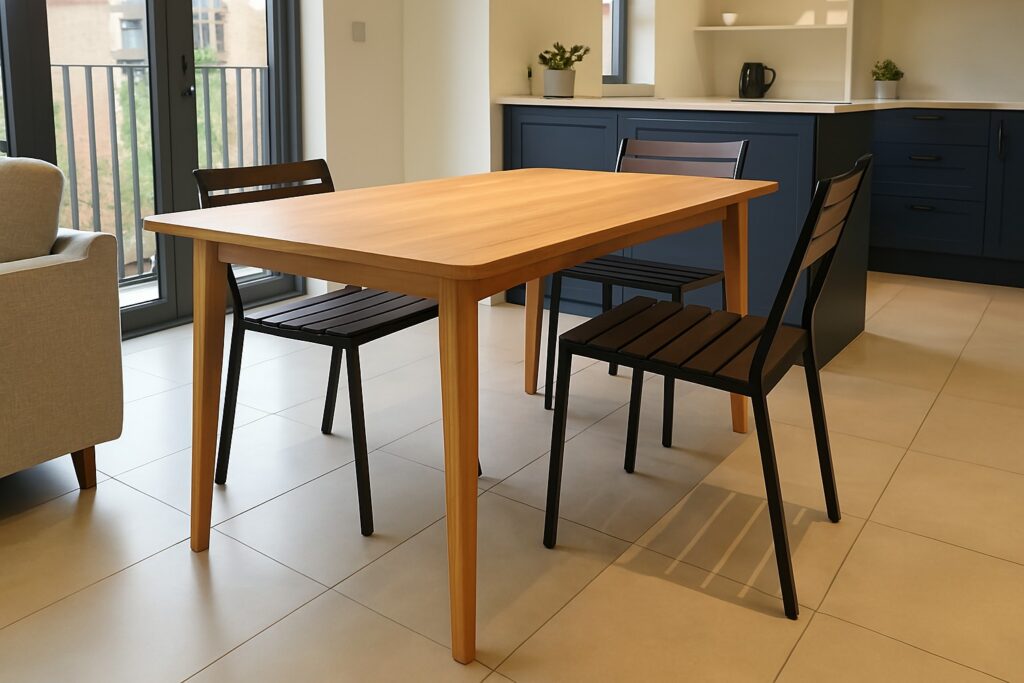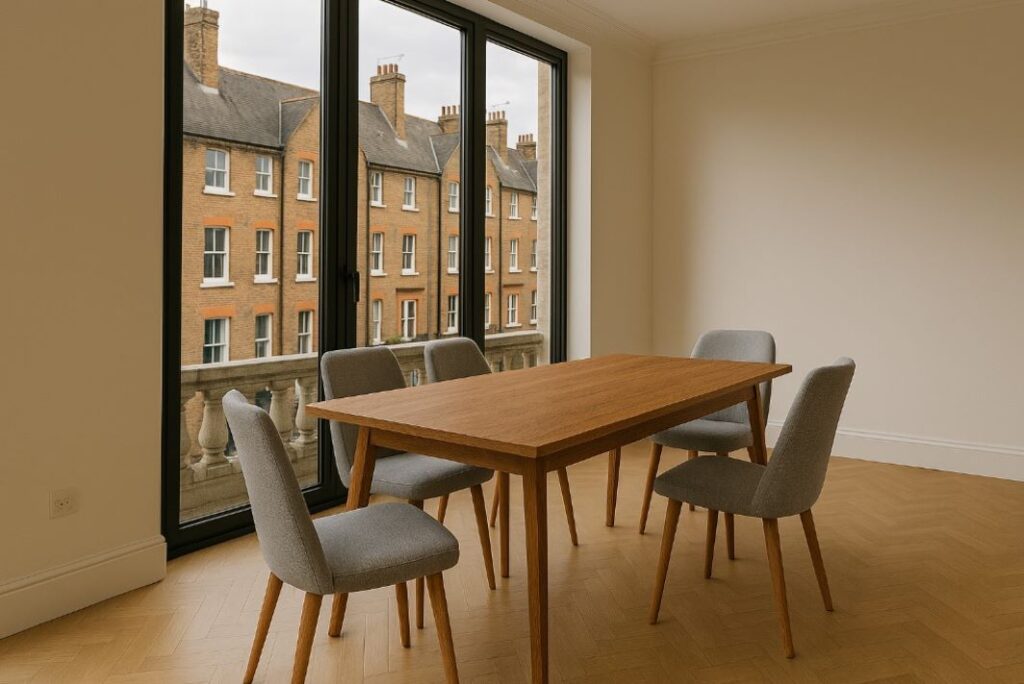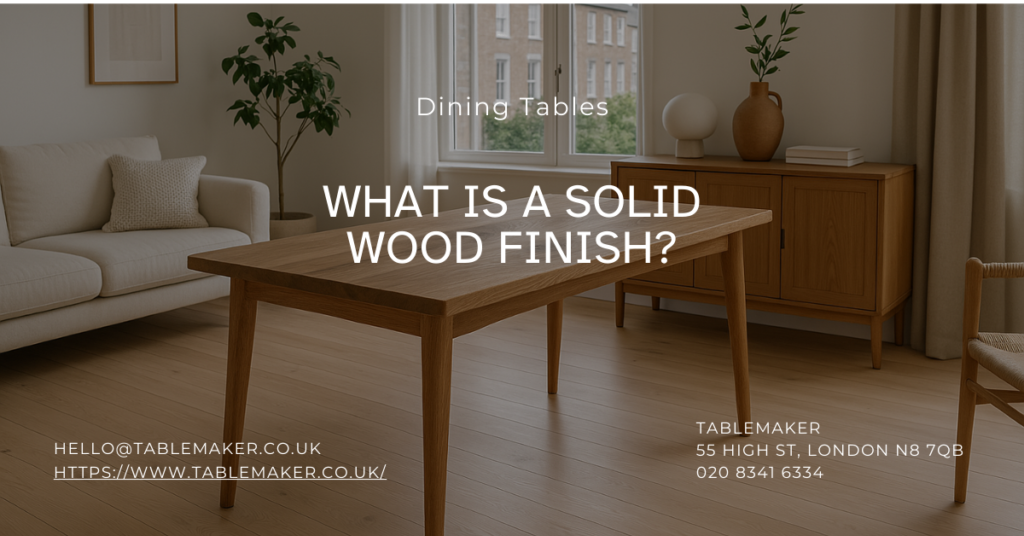
What Is A Solid Wood Finish?
What is a solid wood finish and why does it matter?
A solid wood finish is a protective layer applied to the surface of wooden furniture to improve its appearance and protect it from moisture, wear and tear, and stains. It also highlights the natural grain and character of the timber. The type of finish you choose plays a big role in how your table top or desk performs over time. Whether you want a subtle sheen or a rich depth of colour, understanding the available finishes will help you make the right decision for your space and needs.
In this article about solid wood finishes we have covered
- What is a solid wood finish and why does it matter
- The purpose of wood finishing
- Finish versus stain: what is the difference?
- Which finish is best for a solid wood desk or table top
- How durable are different types of wood finish
- Which solid wood finishes are the safest and most eco-friendly
- Can you choose your own finish when ordering a solid wood top
- Is it worth finishing your own solid wood furniture
- Final thoughts
The purpose of wood finishing
Finishing is the last step in the wood preparation process. It helps seal the wood, preventing it from soaking up moisture or developing stains from everyday use. It also provides a tactile quality that can range from smooth and polished to natural and textured. The right finish can also determine how easy the surface is to clean and maintain.
Finish versus stain: what is the difference?
A common misconception is that a finish and a stain are the same thing. A stain changes the colour of the wood, often using pigment or dye. A finish, on the other hand, can be clear or tinted but is primarily designed to seal and protect the surface. You can stain a surface and then add a clear finish on top to lock in the colour.
Pro Tip: Test the finish on an offcut or hidden underside before applying anything new — even natural oils can shift the colour more than you expect.
Which finish is best for a solid wood desk or table top?
Standard oil and wax finishes
These are often used for their subtle appearance and ease of maintenance. Brands like Rubio Monocoat Oil Plus 2C, Mylands Finishing Oil, and Fiddes and Sons Wax Polish are commonly applied to oak, walnut, and pine. These finishes bring out the natural texture of the grain and can resist water if spills are wiped up quickly. They are especially popular for home desks and dining tables.
Pigmented oil finishes
If you are after a specific tone, especially with oak or pine, pigmented oil finishes offer an easy way to achieve the look. Pigment is added directly to the oil or the wood is stained before sealing. This type of finish allows you to achieve darker tones while still preserving the wood’s texture. Bear in mind that these may require more careful maintenance over time and can be harder to top up if the surface gets damaged.
Stained finishes for colour variation
For a deeper or more uniform tone, stained finishes are a good option. The surface is sanded to a fine grit before being treated with a professional wood stain such as Morrells Light Fast Wood Stain. After setting for a short time, the excess is wiped away before sealing. Staining only darkens the wood, not lightens it, and may complicate future touch ups.
How durable are different types of wood finish?
Finishes that boost longevity
Durability varies widely depending on the type of finish. Hardwearing options like polyurethane and lacquer are often used in commercial or high-traffic settings. They form a solid layer that resists heat, spills, and scratches. These are suitable for public spaces or kitchen worktops but may not suit those seeking a more natural aesthetic.
Oil finishes for easy maintenance
Oil finishes are breathable and allow for simple repairs. You can reapply oil in a localised area without having to refinish the whole surface. This makes them a popular choice for home office furniture and dining tables.
Pro Tip: A lightly worn finish isn’t a fault — it’s often just dry. A quick wipe of the same hardwax oil brings it right back without sanding.
Talk to our Solid Wood Expert in London
Get in touch to refresh or protect your table properly
Which solid wood finishes are the safest and most eco-friendly?
Beeswax
Beeswax is a popular and natural option. It enhances grain patterns and provides a glossy, water-resistant surface. It is food safe, non-toxic, and environmentally gentle. The surface can be topped up annually to maintain its protection and appearance. As reported by BBC Future, natural finishes like beeswax can support more sustainable furniture choices.
Linseed and tung oil
Raw linseed oil is natural and non-toxic but slow to dry. Boiled or polymerised versions contain additives that can emit volatile organic compounds. Tung oil offers a more durable and water-resistant alternative with fewer side effects, provided you avoid chemical blends. Both options are biodegradable and safe once cured. According to The Guardian, choosing low-VOC finishes can significantly improve indoor air quality.
Finishes to use with caution
Traditional varnishes and some polyurethane blends can include chemicals like formaldehyde that raise health concerns. Always check whether the finish is low-VOC or non-toxic. Danish oil and lacquer are popular, but you need to follow safety guidelines during application.
Can you choose your own finish when ordering a solid wood top?
Bespoke finishing options
Many solid wood suppliers offer the option to leave the top unfinished so you can apply your preferred product. Alternatively, you can request a specific finish and the supplier will apply it for you, often sending any leftover product for future maintenance.
Colour matching and sample options
If you want to match existing furniture, you can request colour swatches before ordering. Remember, wood changes appearance based on lighting and the screen you are viewing it on, so physical samples are the most reliable option.
Is it worth finishing your own solid wood furniture?
Buying unfinished
If you prefer full control over the finish, ordering an unfinished top is a cost-effective option. This lets you choose natural, food-safe, or environmentally friendly products, and you can apply the finish in your own time.
Consider your space and needs
A kitchen island may need a different level of protection than a home office desk. Think about how the furniture will be used, how often it needs cleaning, and the kind of wear and tear it will see. This will guide your finish choice and help ensure your top stays looking great for years.
Final thoughts
Choosing a solid wood finish depends on your style, your furniture’s intended use, and your personal preferences for maintenance and environmental safety. Whether you go for a natural beeswax, a rich pigmented oil, or a hardwearing lacquer, there is a finish that will suit your needs. If you are unsure, speak with your supplier about samples or request expert guidance on what will work best for your table or desk.
Explore more guidance and finishing tips in our related articles on how to waterproof a solid wood desk and choosing the right wood type for your room.
Need Help Choosing or Refreshing Your Solid Wood Table Finish in North London?
If you’re based in North London and not sure which finish is right for your table — or if your existing table needs a bit of care — we’re here to help. At Tablemaker, we’ve spent years working with solid oak, advising customers on everything from finish types to easy, at-home maintenance.
Whether you’ve just bought a new table or want to bring life back to an old one, pop in for a chat or send us a quick message. We’re happy to offer honest, no-pressure advice — even if you’re not buying from us right now.
Check out our solid wood dining tables here, Londoners!
Visit us:
55 High Street, Hornsey, London N8 7QB
Call us:
020 8341 6334
Email:
Opening Hours:
Mon–Wed: 9 am–3 pm
Thurs–Fri: 9 am–4 pm
Sat & Sun: Closed
Find more info and browse our tables at www.tablemaker.co.uk
Tablemaker
55 High St, London N8 7QB
02083416334
HVQM+58 London




